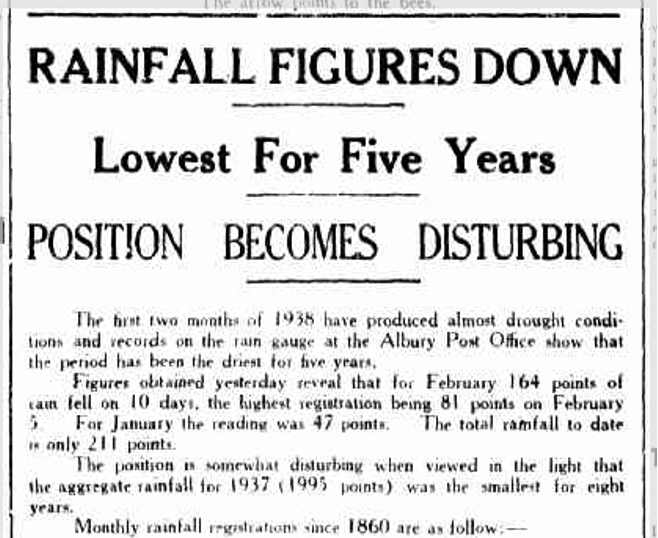
Border Morning Mail, March 1938.
Transcript: POSITION BECOMES DISTURBING. The first two months of 1938 have produced almost drought conditions and records on the rain gauge at the Albury Post Office show that the period has been the driest for five years. Figures obtained yesterday reveal that for February 164 points of rain fell on 10 days, the highest registration being 81 points on February 5. For January the reading was 47 points. The total rainfall to date is only 211 points. The position is somewhat disturbing when viewed in the light that the aggregate rainfall for 1937 (1995 points) was the smallest for eight years. Monthly rainfall registrations since I860 are as follows:—
Story:
Compared to nearby regions, the Albury-Wodonga area experiences high rainfall and abundant water supplies from annual snowmelts which are captured and stored in the nearby Hume Dam. After the Federation Drought (1895-1903) Victoria, New South Wales and South Australia agreed to dam the Murray River to conserve water to guard against future water shortages caused by drought. By the completion of the Hume Dam in 1936, newspapers throughout south-eastern Australia celebrated that the inland agricultural regions had finally been secured against drought.
However, when a dry summer hit in 1938, Albury residents began to feel uneasy over the depleting water supplies. By March, this article in the Border Morning Mail reported somewhat ominously that the region had seen the lowest monthly rainfall tallies in five years. Monthly rainfall registrations extending back to 1860 were appended, offering evidence of long-term meteorological measurements. Despite this, the Border Mail remained optimistic that the dry period was merely a recurring feature of the Australian climate that would be over quickly. It reminded its readers to conserve fodder and water in case autumn rains did not appear, but for the most part, seemed confident that the Albury region was ‘safe’ from all but the most severe cases of drought (BAM 8 April 1938, 4). When the lagoons dried up at the onset of the drought in 1938, engineers at the dam were able to manually feed water into the parched creeks and lagoons of the Bonegilla district, buoying farmer’s faith that the dam would see them safely through a drought. As later ‘drought stories’ in this section demonstrate, this was not to be the case.